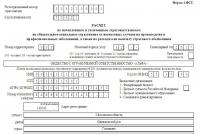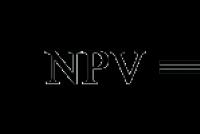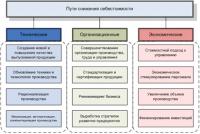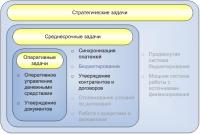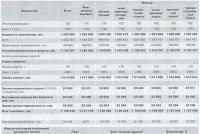Step by step calculation of income tax. How to calculate income tax - rate, calculation example, payment deadlines. Video - Income tax: income and expenses
During the operation of any enterprise, trade is carried out taking into account the fact that it must be profitable. That is why the profitability of the enterprise, its, as well as various coefficients that show the benefits of this business are considered.
That is why, depending on the amount of profit, The organization is subject to certain taxes.
In accordance with the law of the Russian Federation, all enterprises are required to pay for the fact that they conduct commercial activities. But, does everyone pay the same amount, do non-residents of the country give this money, and how much is this very tax? Let's deal with this issue together.
The amount of income tax
If the organization has an accounting or tax accounting, it must pay interest on profits for a specific period. For some, the reporting period is a year, for others - a quarter or a month.
So, for residents of the country, the size income tax is 20%, despite the fact that only 2% goes to the country's budget. The remaining 18 are deducted as income to the regional budget, this rate will be fair only if they are residents of the country.
If you are foreign citizen, you will have to pay a rate of 20%, plus another 10% is the transport rate paid by all non-residents.
So, income tax is a direct tax. The value of which directly depends on the profit that the organization will receive for a certain period, be it a month, quarter or year. That is, it should be charged on the difference that the organization received by selling the product and spending on it.
So, he pays this tax:
- All legal entities that are citizens of the Russian Federation;
- Persons who are not residents of the Russian Federation, but receive profit from this;
- Foreign organizations that are recognized by the tax authorities, or if it is recognized by documents under international agreements;
- Organizations that were not registered by residents of the country, but obey Russian law;
But, there are people who do not pay this tax:
- Those who pay gambling tax;
- Persons who have a special system of taxation, in connection with legal acts;
- Participants of special projects;
Thus, there is a special group of people who do not pay at all, or pay much less than the main objects.
Determining the tax base
Thus, in order to take:
- Income received from the sale of goods and services;
- Dividends that various enterprises bring;
- Money from renting out your property;
- Other income funds;
So, in order to calculate all the profit that the organization will learn, you will need to know the data that it received from the sale of all goods and services. To determine the current income tax, you cannot select only one product or service, you must add all income from the sale of goods.
So, for example, if you are selling household goods, and received the following income:
- from the sale of shampoo - 100,000 rubles,
- from the sale of soap - 50,000 rubles,
- from the sale of gels - 180,000 rubles,
then for the correct calculations, you will need to add all the income:
100,000 + 50,000 + 180,000 = 330,000 rubles.
It is this figure that will be useful to you for all further calculations.

Calculation formula
The income tax paid by a resident of this country is 20%, but it is this figure that is divided into two parts, so 2 percent belong to the state budget, and therefore go there. The remaining 18 usually go to the regional budget.
So, the formula for calculating the federal budget will be:
Income tax * 2%= income tax to the federal budget;
And to calculate the tax to the regional budget, it is necessary to replace only one figure:
Income tax * 2%= profit tax to the regional budget;
That is, if you are a resident of the Krasnodar Territory, and the headlight company brings about 100,000 rubles a year, then you will give 20,000 rubles for income tax, of which 2,000 rubles will go to the state budget, and the remaining 18,000 rubles to the regional budget of the Krasnodar Territory.
Calculation example
Imagine that you are the head of an enterprise, you sell household goods, and you decide to take out a loan for 900,000 rubles, for example, for depreciation or other unplanned expenses.
- How did you pay the down payment? 200,000 rubles;
- For the first year of operation, you made a profit 2 million rubles;
- VAT on 200,000 rubles;
- Costs of raw materials, electricity and other expenses amounted to 300,000 rubles;
- wage payments cost at 50,000;
- insurance premium of 60,000 rubles;
- depreciation - 50,000 rubles;
- loan interest - 40 000 rubles, given that the losses incurred amounted to 100,000 rubles.
 In total we spent this year - 300 200
In total we spent this year - 300 200
But they earned: 1,199,800 rubles.
Then: 2,000,000 rubles - 200,000 rubles - 300,200 rubles - 100,000 rubles = 1,400,000 rubles
To calculate the current income tax, you must
1,400,000 rubles * 20% / 100% \u003d 280,000 rubles.
Then, it will reach the country's treasury: 280,000 * 2% / 100% = 5,600 rubles
And in the regional budget will remain: 280,000 * 18% / 100% = 50,400 rubles.
If you are the head of an organization, you will need these formulas to calculate income tax. After all, this is how you can independently check how much the company should give money to the state.
So, income tax is an important indicator for the tax office, any action requires reporting, and therefore from the reports of accountants you will see how much you need to pay as a tax. 
Also, this indicator must be taken into account when you are just going to open a business.
There are many cases when, before starting a business, a person calculates expenses and incomes, and receives a certain figure.
But he absolutely does not take into account the figure of the tax. As a result, when opening a business, at the end of the reporting period, he will see that the amount can be much less than expected, and it will be good if it remains positive at all. After all, no one is immune from losses.
For calculations you can use formulas and calculate manually, or go to the online calculator and get the result within a few seconds, only by entering basic data, such as the amount of net income.
All legal entities applying the OSNO (general taxation regime) are required to pay corporate income tax - how to calculate it in 2017 is described in detail below. This requirement is also valid for foreign enterprises operating in the Russian Federation. Chapters are not used. 25 companies on the USN, ESHN, UTII, as well as representatives of the gambling business and enterprises participating in the Skolkovo innovation direction.
According to stat. 286 of the Tax Code is required to be performed based on the results of the reporting (advance charges) and tax (total amount) periods. The interest rate is approved at the federal level and in 2017 is 20%, of which 3% goes to the budget of the Russian Federation, 17% to local authorities.
Note! The structure of income tax according to the general rules consists of 2% federal deductions and 18% deductions to the local budget. But for the period 2017-2020. there is a distribution according to the federal / local budget of 3/17%. At the same time, the authorities of the constituent entities of Russia have the right to establish reduced local tariffs for certain categories of taxpayers, but not less than 13.5%, and for 2017-2020. 12.25%.
How to calculate income tax - important nuances:
- To determine income, sales receipts (stat. 249 of the Tax Code) and non-operating income (stat. 250 of the Tax Code) are summed up.
- To determine the costs, sum up the costs by type (depreciation, material, wages) and non-operating (stat. 252-256, 265 TC).
- Do not participate in the calculations of income according to Art. 251 and costs according to art. 270 NK.
- The procedure for determining certain types of expenses, for example, in the formation of reserves, repair of fixed assets, insurance, is prescribed in Chapter 25 of the Tax Code.
Before you start calculating the exact tax figure, you should calculate the taxable base. According to stat. 274 of the Tax Code, the base in terms of income taxation is calculated separately at various rates. At the same time, it is important to know in which particular period of time it is possible to recognize the received income and / or expenses. Accounting for receipts is carried out using one of the available methods:
- Accrual method - recognition of income/expenses is carried out in accounting at the time of actual implementation (costs incurred), regardless of the date of settlements with counterparties. Cash receipts of cash and non-cash funds, settlements with property and rights are recognized as payment.
- Cash method - recognition of income/expenses is carried out in accounting at the time of payment. Taxpayers with revenue without VAT for the past 4 quarters of no more than 1 million rubles are entitled to apply this method. for every.
How to Calculate Profit Before Tax
Regardless of the method by which income and expenses are determined in the company, a single mathematical algorithm is used. The following formula is used in the calculations for the required period:
Value for the income tax period = Tax base (Total income - Total expenses) x Tax rate - Advance amounts paid for previous reporting periods.
The calculation is extremely simple, but you need to remember this. All indicators are calculated incrementally. If the result is a negative value, the company has suffered a loss and the tax is not paid. Losses from previous years reduce the tax base in a special manner. If a company uses multiple tax rates, you should calculate each one separately. The total amount of tax is calculated for the calendar year, and advance charges are calculated during the year.
Special conditions for determining income tax
Chapter 25 establishes special conditions for certain categories of profit payers. The procedure for recognizing income and expenses differs by groups of organizations or areas of activity. In particular, when determining the taxable base, nuances are provided for:
- Banks and insurers.
- Participants of the professional securities market.
- clearing companies.
- foreign enterprises.
- Operations on futures transactions with financial instruments.
- Operations under agreements of simple partnership or trust management of property.
Details of taxation of the companies and situations indicated above are contained in the Tax Code of the Russian Federation.
How to calculate income tax - an example
Let's assume that Fortuna LLC is engaged in wholesale trade in spare parts. The main activity is the wholesale of spare parts, additional activities are the leasing of premises: one-time operations. An accountant, based on tax accounting data, determines taxes for 1 sq. 2017
Initial data:
- Taxation system - OSNO.
- Sales proceeds for 1 sq. 2017 - 8260000 rubles, including VAT 18% 1260000 rubles.
- Income under the lease agreement - 106,200 rubles, including VAT 18% 16,200 rubles.
- Expenses for 1 sq. - salary 150,000 rubles, depreciation 55,000 rubles, deductions for insurance premiums 45,000 rubles, interest on loans received 23,000 rubles.
The amount of income \u003d Sales income (8260000-1260000) + Non-operating income (106200 - 16200 + 23000) \u003d 7000000 + 113000 \u003d 7113000 rubles.
The amount of expenses \u003d 150,000 + 55,000 + 45,000 \u003d 250,000 rubles.
Profit before tax \u003d 7113000 - 250000 \u003d 6863000 rubles.
The amount of tax for 1 sq. 2017 \u003d 6863000 x 20% \u003d 1372600 rubles. everything, including:
For payment to the federal level = 6,863,000 x 3% = 205,890 rubles.
For payment to the local budget = 6,863,000 x 17% = 1,166,710 rubles.
Since the total quarterly revenue does not exceed the established limit of 15,000,000 rubles. (Article 286, paragraph 3 of the Tax Code), the organization pays tax in quarterly advance amounts. Transfer payments for 1 sq. 2017 required by April 28, 2018
Transaction entries:
- D 99 K 68 for 205890 rubles. and for 1,166,710 rubles - the accrual of income tax is reflected.
- D 68 K 51 at 1372600 - the tax was transferred to the budgets.
If you find an error, please highlight a piece of text and click Ctrl+Enter.
How to calculate income tax for organizations using the general tax system? There are many nuances and pitfalls here, and the tax must go to the budget on time and in the right amount. Consider how this mandatory payment should be calculated in accordance with the requirements of the law.
Object of taxation and tax rate
- For Russian organizations and foreign companies working through representative offices, these are incomes reduced by the amount of expenses.
- If an organization is included in a group of taxpayers, then the object of taxation for it is determined taking into account interaction with other companies of the group.
- For foreign companies that do not have representative offices, the tax base for income tax is calculated as the amount of income received in the territory of the Russian Federation.
The second element required in order to determine how to calculate corporate income tax is the tax rate. To date, the base rate has been approved at 20% (Article 284 of the Tax Code of the Russian Federation). This article also contains a large number of exceptions related to the type of activity, payer category, type of income, etc.
How to calculate income tax
The calculation of income tax in the general case is carried out as follows:
NP \u003d (D - R) X St,
where D&R respectively, income and expenses,
St- tax rate.
In practice, the income tax formula is much more complicated.
Income consists of proceeds from core activities and various types of non-operating income. In addition, an organization may receive income taxed at different rates, which should be accounted for separately.
Expenses are even more interesting. A large part of ch. 25 of the Tax Code of the Russian Federation is devoted to the nuances of recognizing various types of expenses for different types of activities and categories of organizations. Simply transferring data from accounting in most cases is not enough; it is necessary to take into account the nuances of recognizing costs in tax accounting. For example, depreciation for the same object can be calculated in accounting and tax accounting by various methods. In this case, tax differences arise.
Read also Advance income tax payments: mechanism and timing
Among the costs of the organization, a number of main items can be distinguished, and the formula for the current income tax will include all these indicators:
- Raw materials and materials (for trading companies - purchase of goods).
- Salary and contributions to extrabudgetary funds.
- Depreciation.
- Fuel and electricity costs
- Third party services (rental, communication, audit, etc.)
- Other expenses.
- Non-operating expenses (for example, interest on loans)
At the end of 2017, the enterprise had the following financial indicators (excluding VAT):
Revenue - 100 million rubles.
Received interest on loans - 6 million rubles.
Material costs - 40 million rubles.
Remuneration and contributions - 25 million rubles.
Utility payments - 5 million rubles.
Services of third-party organizations - 10 million rubles.
Interest on loans - 6 million rubles.
Determine the tax base and the amount of tax:
Income tax formula
We substitute our data into the formula for calculating income tax:
NB \u003d (100 + 6) - (40 + 25 + 5 + 10 + 6) \u003d 20 million rubles.
NP \u003d NB x 20% \u003d 20 million rubles. x 20% = 4 million rubles.
Tax and settlement periods for income tax
The third important element that is needed to understand how income tax is calculated is the tax period. In terms of income tax, it is a year. However, if all enterprises begin to pay this tax once a year, then budget revenues will be uneven. Therefore, advance payments have been introduced, which can be of three types (Article 286 of the Tax Code of the Russian Federation).
Income tax is a phrase familiar to most entrepreneurs. But what does it mean? How to calculate income tax correctly?
Why do you need to pay taxes?
First of all, you need to understand that income tax is a source for replenishing the state budget. And one of the main ones. It is required to pay enterprises and companies engaged in entrepreneurial activities. However, the law provides for a number of exceptions. Let's figure out how to calculate income tax. An example will be presented below.
The maximum amount of tax is twenty percent, the minimum is fifteen. There is also a preferential type of tax. It is equal to thirteen and a half percent.
Who is exempt from income tax, and who must pay it?
Russian and foreign companies that make a profit in the territory of the Russian Federation are required to pay taxes. Another condition for foreign companies is that they work through a Russian representative office. Completing an income tax return often raises many questions.
Exempt from payment:
Individual enterprises;
Firms operating on special regimes;
Foreign companies whose activities are related to the holding of the Olympic Games in Sochi;
Companies preparing for the World Cup.
Income subject to income tax

The income of organizations from which income tax must be withheld is listed by law. According to the law, the tax must be collected from:
Income received as a result of the organization's activities;
Profit of past financial years, if it was found only in this one;
Positive or negative exchange rate differences;
Interest on loans received;
canceled loan debts;
Prices of things identified during the inventory.
Non-taxable income
There are also incomes on which corporate income tax is not levied. The peculiarity of the list of these incomes is that it is finite. That is, this list cannot be increased. The question of how to calculate monthly income tax payments is not worth it in this case.
This list includes:
Prepayment for goods made by an organization using the accrual method;
Funds received on loan;
Property, more precisely, its value, when it is contributed as part of the authorized capital of the organization;
Income, which can be expressed both in cash and in property, received by the company as a result of intermediary activities;
Special-purpose financing;
Provided improvements to fixed assets, if they were provided free of charge;
Improvements made by the landlord of the premises;
Property that was received from an individual on a gratuitous basis, if his share in the authorized capital of this organization is more than fifty percent;
Property that was received from a legal entity on a gratuitous basis, if its share in the authorized capital of this organization is more than fifty percent;
Property that was received from another organization on a gratuitous basis, if its share in the authorized capital of this organization is more than fifty percent.
Expenses subject to tax

In accordance with the law, not only income, but also expenses are taxed. All taxable expenses can be conditionally divided into a number of groups.
The first of them is related to the remuneration of employees of the company. It includes:
their wages;
Premiums paid;
Compensation provided for by the Labor Code;
Surcharges related to a number of reasons specified in the law;
Long service payments;
Insurance payments, regardless of whether they are mandatory or voluntary;
Payments for the time of forced downtime in the activities of the company;
Accruals issued in case of reorganization of the company;
Accruals issued as a result of downsizing;
Funds reserved for paying wages to workers, paying for holidays (the calculation of the current income tax will be discussed by us below).
The next group is called material costs. It includes:
Depreciation;
Rental of premises;
Referring to the services of other companies;
Education;
Insurance, both compulsory and voluntary.
non-operating expenses

Non-operating expenses are the next group of expenses that are subject to taxation. It includes:
Interest on credits, loans of the organization;
Interest on securities;
Legal costs;
shortages;
Payments for violation of the established terms of the contract;
Losses for previous years, which were calculated only in this one;
Losses due to force majeure.
Expenses that are not taxable
The Tax Code also provides for a list of expenses not subject to income tax. This will help you complete your income tax return correctly.
These expenses included:
Contributions made by the founders to the authorized capital of the organization;
Taxes for exceeding the norms for emissions of harmful substances into the environment;
Fine, which must be transferred directly to the state budget;
Payments for members of the board of directors;
Remuneration paid to members of the board of directors;
Deductions created in case of depreciation of investments in securities;
Losses due to maintenance of production;
Prepayment made for the goods, if accrual methods were used;
Property that was transferred on loans;
Funds transferred as a result of the loan agreement;
Contributions to affiliates made on a voluntary basis;
Transfer of property free of charge;
Expenses for the gratuitous transfer of property;
Rest and treatment of employees on a voucher;
Organization of visits to various cultural or sports events for employees of the organization;
Payment for travel for an employee, if it was not provided for by the collective agreement;
Meals on a preferential or free basis, if this was not provided for by applicable law.
Now that it is clear from which amounts the tax is withheld and which are not, it's time to move on to calculating the amount of taxes. How to calculate income tax? The formula for this has been derived. According to it, the amount of tax is obtained as a result of deducting the amount of its total expenses from the total income of the organization. The resulting value is multiplied by the tax percentage and divided by one hundred.
Now let's deal with possible obscure terms. The total income is made up of all activities of the organization.
The total expense combines the production, advertising, depreciation costs and wages of employees.
The amount received as a result of these simple mathematical operations is equal to the amount of taxes that must be paid.
How to calculate income tax: an example

In order to finally understand how income tax is calculated, you need to try to do this on the example of any fictitious organization. Let's call it "X". So, the total income of the organization is 100,000,000. The total expenses are 500,000. Let's take the standard tax rate of twenty percent.
To begin with, we subtract 500,000 from 100,000,000. We get 500,000. We multiply 500,000 by 20. We get 10,000,000. And we divide 10,000,000 by 100. In total, the total amount that must be paid by the organization as income tax is 100 thousand.
One more calculation
Now let's take a look at a more complex example. The income of the organization is 50,000 thousand rubles. At the same time, she received 30,000 rubles for her additional activities. The salary paid to employees is 20,000 rubles. 5,000 rubles were spent on advertising activities. Production costs - 15,000 rubles. And the depreciation expense amounted to 7,000 rubles. At the same time, the organization operates in Moscow, and disabled people work in it. Let's try to calculate the income tax in this situation.
First, calculate the total income and total expenses. In order to understand what the sum of the total income is, we add up 50,000 and 20,000. The total income of the organization is 70,000 thousand rubles.
Let's determine the total cost. We add up 20,000, 5,000, 15,000 and 7,000. We get 47,000 thousand rubles.
Now, subtract the total expense from the total income. That is, we subtract 47,000 from 70,000. We get 23,000.
Now is the time to multiply the amount received by the tax percentage rate, only in this situation it is not twenty, but thirteen and a half, since disabled people work in the organization. So, we multiply 23,000 by 13.5. We get 310 500. Divide by one hundred. The organization must pay a total of 3,105 rubles as income tax. And consider a similar case, but with a standard tax rate.
The organization's income from permanent activities is 250,000 rubles, from its additional activities it received another 100,000 rubles. 90,000 rubles were spent on salaries for workers. Production needs took 90,000 rubles. Depreciation cost 50,000 rubles. Now we determine the amount of income tax.
First, add up all the income of the organization. We get 350,000 rubles. Then we calculate the amount of expenses by adding up the money spent on wages, production needs and depreciation. As a result, 230,000 rubles are obtained.
Now subtract the two sums from each other. We get 120,000 rubles. Multiply by the tax rate equal to twenty. We get 2,400,000. Divide the result by one hundred. Total - 24,000 rubles. It is this amount that the organization must pay as income tax. Now it is clear how to calculate the amount of income tax.
Possible errors in tax calculation

The formula for calculating income tax is very simple. It is almost impossible to make a mistake in it, but sometimes errors occur.
First of all, they are usually associated with incorrect calculations. The reason is errors in accounting.
It is also not uncommon for errors to occur due to incorrect tax rates being used in the calculation process. As a general rule, the tax rate is twenty percent. However, there is a list of benefits, as a result of which it can be reduced to thirteen and a half. Discounted rate depends on:
From the region in which the organization operates;
From the activities carried out by the organization;
Sanctions provided by the state for tax evasion
Organizations must be engaged in maintaining tax records constantly. All types of both income and expenses are subject to registration. Regardless of whether they are primary or secondary.
The procedure for paying taxes is regulated by the tax code, which also indicates a number of sanctions for non-payment. The effect of these sanctions is controlled by the state, they include penalties, fines, additional tax charges.
How to calculate personal income tax?

Do self-employed individuals have to pay income tax? This question worries and misleads many individual entrepreneurs. However, the answer to it is extremely simple and understandable. According to article 246 of the Tax Code of the Russian Federation, only legal entities should pay income tax. These include various organizations, enterprises, institutions, and so on. Individual entrepreneurs, in turn, do not belong to legal entities, and, as a result, income tax does not apply to them.
This fact, of course, does not exempt individual entrepreneurs from all other types of taxes.
The question is often asked how to calculate the income tax of the simplified taxation system (with a simplified taxation system). Everything is quite simple here - you need to decide on what tax to pay. An entrepreneur can do this from income (in this case 6%) or from the difference between revenue and expenses (15%). With simple calculations, the second option is more profitable.
All commercial organizations that carry out their activities in the territory of the Russian Federation are subject to taxation. The income tax rate is calculated based on the territorial location of the enterprise, but is not less than 15% and not more than 20%. There are also certain exceptions described in the Tax Code of the Russian Federation, therefore, in order to know how to calculate income tax, you need to familiarize yourself with the relevant articles of the Code, the interpretation of which is given below.
Functions, procedure and example of income tax calculation
Income tax is a direct tax, which is levied in favor of the state on the company's profit, which is the sum of the income of the enterprise's activities minus deductions and discounts.
The introduction of any tax pursues certain goals. In total, there are four functions of income tax:
- fiscal;
- regulatory;
- control;
- social.
The first function allows the state to form budgets for various needs and create a material base for full-scale development. The regulatory function, in turn, is necessary to influence economic processes in order to take anti-crisis measures and distribute incomes of the population. The instruments of the regulatory function are the systems of tax incentives and payments, which allow influencing the economic spheres. The control function is necessary to track the development of economic entities and evaluate the effectiveness of the taxation system. The social function is applied on the basis of fiscal and regulatory in order to help the low-income segments of the population by collecting payments from the segments of the population with high incomes.
So how to determine the income tax, taking into account all types of activities subject to taxation? First of all, you need to know that this direct tax is subject to:
1. Sales income - finance received by the company from the sale of a service, work or product. All goods are taxed, regardless of whether the enterprise has its own production or purchases goods for subsequent resale.
2. Income that is not related to the main activities of the organization. For example:
- income received as a result of a positive change in the exchange rate or amount difference;
- write-off of the loan;
- property received free of charge;
- interest on loans, credits and bills.
income tax–formula:
NP \u003d (OD - OR) * SNP / 100, where:
NP - income tax;
OD - total income;
OR - total consumption;
SNP - income tax rate, expressed as a percentage.

